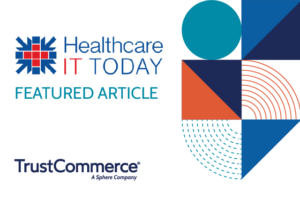The No Surprises Act, a new federal regulation that aims to end surprise billing for American patients, is part of a growing industry trend towards price transparency in healthcare that signifies shifting patients expectations of providers.
As the healthcare consumerism trend has evolved, patients have increasingly begun looking for the type of convenient and easy-to-use digital tools from their providers that they relied on during pandemic-related lockdowns and depend on in other industries like retail, banking, and groceries. In healthcare these tools give patients the ability to self-schedule appointments, check-in to appointments online, obtain pre-service cost estimates, and gain greater flexibility when paying for high-cost bills.
Patients’ need for healthcare price transparency and patient payment flexibility has grown as they have had to cover a higher amount of out-of-pocket costs due to the growing use of high-deductible health plans.
For example, the share of patient statements with balances of more than $7,500 grew from 5.2% in 2018 to 17.7% in 2021, while the percentage of balances higher than $14,000 increased from 4.4% in 2018 to 16.8% in 2021, according to a report from Crowe Revenue Cycle Analytics.
That is significant for providers because generally, the higher the out-of-pocket costs, the less likely providers are to collect what they are owed. The report found that the collection rate in 2021 for claims between $5,000 and $7,500 was 32%, while the collection rate for claims between $7,501 and $10,000 was 17%.
Unpacking the No Surprises Act
In August, the U.S. Departments of Health and Human Services released the final rules pertaining to the No Surprises Act, which aims to restrict surprise billing for patients in job-based and individual health plans who get emergency care, non-emergency care from out-of-network providers at in-network facilities, and air ambulance services from out-of-network providers.
For providers, the new regulations include new provisions that:
- Establish an independent dispute resolution process to determine out-of-network payment amounts between providers or facilities and health plans.
- Require good faith estimates of medical items or services for uninsured or self-paying individuals.
- Establish a patient-provider dispute resolution process for uninsured or self-paying individuals to determine payment amounts due to a provider or facility under certain circumstances.
For patients, the No Surprises Act will deliver the following benefits:
- Ban surprise bills for emergency services, even if they are obtained out-of-network and without prior authorization.
- Ban out-of-network cost-sharing, such as coinsurance or copayments for all emergency and some non-emergency services. Patients can’t be charged more than in-network cost-sharing for these services, and any cost-sharing patients pay counts towards deductibles and maximum out-of-pocket limits for the policy year.
- Ban out-of-network charges and balance bills for supplemental care, like anesthesiology or radiology, by out-of-network providers who work at certain in-network facilities, such as a hospital or ambulatory surgical center.
- Require that providers and facilities give patients an easy-to-understand notice explaining that getting care out-of-network could be more expensive, and patients’ options to avoid balance bills.
Given the federal government’s heavy emphasis on delivering price transparency to consumers through regulations like the No Surprises Act, providers should expect patients to advocate for more and more visibility into anticipated prices in the future. That’s where convenient digital patient engagement tools enter the pictures.
Digital tools to promote convenience and price transparency in healthcare
Providers who evolve with changing patient expectations for a more transparent, retail-like consumer experience in healthcare can increase patient satisfaction, and potentially patient volumes through more efficient operations. Following are four digital tools providers can adopt to deliver more transparency and convenience throughout the patient journey.
Self-scheduling: Consumers have come to expect the ability to self-schedule events online, such as dinner reservations, oil changes, and hairstyling appointments, and increasingly look for providers to offer online appointment scheduling. When providers give patients the option to self-schedule appointments, rather than requiring them to call for appointments during office hours, they can reduce barriers to care and improve patient satisfaction.
Automated appointment reminders: After patients book appointments, providers can use digital tools to send automated appointment reminders at specified intervals, such as a day or week prior to scheduled visits. Providers or staff can configure automated reminders to match patient preferences for channel of contact, whether text messages, emails, or phone calls, to increase patient engagement and satisfaction.
Pre-service check-in and cost estimates: Online pre-service check-ins enable patients to confirm important data – such as demographic information, insurance and benefits coverage, copay, and service amount estimate based on visit type – prior to a telehealth or in-person visit. With pre-service cost estimates, providers can collect co-pay and out-of-pocket costs at check-in, while at the same time storing the patient’s credit card information to automatically bill for any balance due.
Post-visit payment plans: By offering flexible payment plans, providers enable patients to better manage the large expenses often associated with medical bills. Additionally, flexible post-visit payments plans can help providers improve collections and reduce the amount of bad debt sent to collections agencies.
While the No Surprises Act is among the latest regulations that encourage more healthcare price transparency solutions from providers, it surely won’t be the last. With digital patient engagement tools that promote greater transparency and convenience for patients, providers can prepare themselves for the new era of patient consumerization.
For information on how to centralize healthcare payment processing across apps, contact TrustCommerce.






